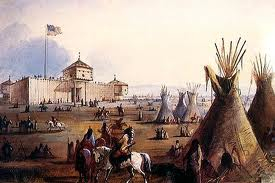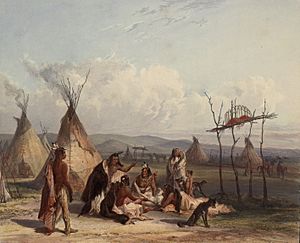Wagluhe facts for kids
The Wágluȟe Band is one of the seven main groups of the Oglala Lakota people. They are also known as the Loafer Band.
The seven Oglala Lakota Bands are the Wágluȟe (Loafers), Ite Sica (Bad Face), Oyukpe (Broken Off), Wazaza (Shred Into Strips), Tapisleca (Split Liver), Payabaya (Shove Aside), and Kiyaksa (Little Wound).
Contents
Old Chief Smoke and the Wágluȟe
Old Chief Smoke was an important Oglala Lakota chief. He was also one of the last great Shirt Wearers, a respected group of Lakota warriors. His family, the Smoke people, was very well-known in the 1700s and 1800s.
Chief Smoke was one of the first Lakota chiefs to understand the power of the white settlers and why it was important to work with them. In 1849, he moved his Wágluȟe camp to Fort Laramie, Wyoming. This happened when the U.S. Army set up a post there. The army wanted to protect and supply wagon trains of white travelers on the Oregon Trail.
Other Lakota families who wanted safety also joined Chief Smoke's camp at Fort Laramie. Chief Smoke knew that the white settlers were very numerous and that fighting them might not work. He watched and learned about their ways.
By the late 1850s, some Lakota from the buffalo-hunting camps started to call Chief Smoke's community "Wágluȟe" (Loafers). This name meant they were like people who depended on others, or "hangers-on." But some Wágluȟe thought the wild Lakota were like country folk.
During the conflicts of the 1860s, Fort Laramie became a military base. It was a main spot for the U.S. Army during Red Cloud's War. In 1864, Old Chief Smoke passed away. He was laid to rest near his beloved Fort Laramie. His son, Chief Big Mouth, became the new leader.
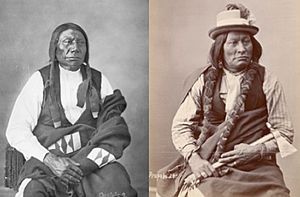
Life at Fort Laramie
The Wágluȟe understood the strength of the white settlers. They knew that fighting a large war against them would be very difficult. In traditional tribal wars, a fight with 50 warriors where two people died was considered a big battle. The Wágluȟe at Fort Laramie, Wyoming heard about the 50,000 people who died in the three-day Battle of Gettysburg in 1863. This helped them understand what white men meant by a "battle."
The Wágluȟe watched and learned the customs of the white people. The U.S. Army and Indian agents saw the Wágluȟe as the most forward-thinking Lakota group. Many Wágluȟe became Indian Police or U.S. Army Indian Scouts with the U.S. 4th Cavalry Regiment from Fort Laramie. They also helped communicate with other Lakota groups.
The Wágluȟe set up a system of leadership at Fort Laramie. Old Chief Smoke appointed Chief Blue Horse and Chief Big Mouth as the first Indian Police officers. The Wágluȟe were also the first Oglala Lakota to send their children to the Carlisle Indian Industrial School in Carlisle, Pennsylvania, for a formal education.
Wágluȟe U.S. Army Indian Scouts were like a "Band of Brothers" with U.S. Army Cavalry Scouts. Later, they were the first Oglala Lakota to travel with Colonel William Frederick "Buffalo Bill" Cody and his Wild West show across the U.S. and Europe. These Wágluȟe, who had fought in the Great Plains Wars, chose to work with Buffalo Bill. They valued that the Wild West shows helped keep Oglala Lakota traditions alive. This was important at a time when the Bureau of Indian Affairs wanted Native Americans to adopt American ways of life.
The Death of Chief Big Mouth
Chief Big Mouth was the older son of Old Chief Smoke. He became the head chief in 1864 after his father died. Chief Big Mouth disagreed with Chief Spotted Tail's leadership. He also criticized how Spotted Tail talked with politicians in Washington.
On October 29, 1869, Spotted Tail went to Chief Big Mouth's lodge and asked to speak with him. When Big Mouth came out, he was held by two warriors. Then, Chief Big Mouth was killed during a conflict with Spotted Tail.
Captain DeWitt C. Poole, who worked at the Whetstone Indian Agency, reported that Chief Blue Horse was very upset and angry about his brother's death. Blue Horse was very emotional, expressing his anger and threats towards Spotted Tail. Chief Big Mouth died around dawn.
Later, Blue Horse went to agent Poole's office. He said he was so sad that he needed to begin mourning. The interpreter warned Poole that if Blue Horse started mourning, it could lead to more fighting. To prevent this, the agent offered Blue Horse two blankets to comfort him. Blue Horse accepted the blankets and left quietly. Poole later reported that Spotted Tail paid a certain number of ponies to Blue Horse. This was seen as a way to settle the conflict according to their traditional laws.
Chief Blue Horse was encouraged to get revenge for his brother's death. However, he chose a peaceful path. He moved his Wágluȟe Band to a different area instead. Chief Red Cloud was also saddened by his brother's death. Even so, Chief Red Cloud continued to work with Chief Spotted Tail. They traveled to Washington, D.C. together to protect tribal lands, make sure treaties were followed, and preserve Lakota heritage.
Wágluȟe Leadership Changes
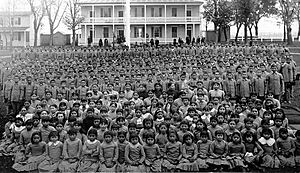
After the Battle of the Little Bighorn and the arrest of Chief Blue Horse in 1876, the Wágluȟe divided into three groups. Chief Blue Horse remained the head chief of one group. Two other groups were led by younger leaders, American Horse and Three Bears. Red Shirt was also a popular leader and helped Three Bears.
These leaders had many things in common. Blue Horse, American Horse, Three Bears, and Red Shirt all served as U.S. Army Indian Scouts with the U.S. 4th Cavalry Regiment from Fort Laramie, Wyoming. They also led Lakota groups to Washington, D.C. Their children attended the first class at the Carlisle Indian Industrial School in Carlisle, Pennsylvania. And all of them joined Buffalo Bill's Wild West show.
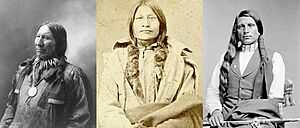
Red Cloud's Role
Red Cloud was known as a leader of both the Wágluȟe and the Ite Sica bands. In 1860, Lieutenant Henry E. Maynadier, who later commanded Fort Laramie, recognized Red Cloud as one of Old Chief Smoke's sons, a Wágluȟe. However, when the Oglala Lakota faced serious threats, Red Cloud often became the main chief of the Ite Sica (Bad Faces) band.
Chief Blue Horse's Legacy
In 1890, Native American historian Charles Eastman met Chief Blue Horse at the Pine Ridge Indian Reservation in South Dakota. Eastman reported that Chief Blue Horse was his "first caller" at the agency and was the respected former chief of the Wágluȟe Band.
Eastman described Blue Horse as opening the door quietly, in a typical Indian way. After greeting him, Blue Horse showed his papers from various high military officers, dating from 1854 to 1877. These papers proved his past service. Eastman noted that Blue Horse mostly wanted to share his stories.
Eastman wrote that Blue Horse had been a friend to the white man. He was one of the first Sioux U.S. Army Indian Scouts. He was also one of the first to travel across the ocean with Buffalo Bill.
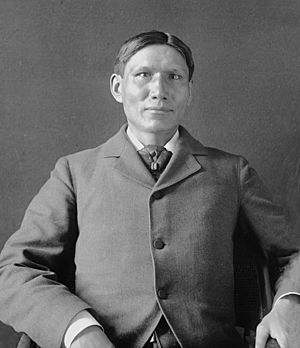
Wild West Shows
Wágluȟe U.S. Army Indian Scouts from the Pine Ridge Indian Reservation, South Dakota, were the first Oglala Lakota to travel with Colonel William Frederick "Buffalo Bill" Cody and his Wild West show. They toured throughout the U.S. and Europe.
Veterans from the Great Plains Wars chose to work with Colonel "Buffalo Bill" Cody. They appreciated that the Wild Westing shows helped preserve Oglala Lakota heritage. This was important during a time when the Bureau of Indian Affairs was trying to encourage Native Americans to adopt American ways of life.


